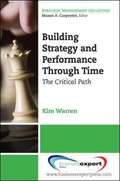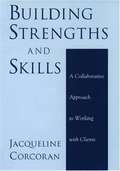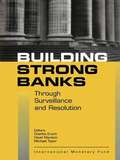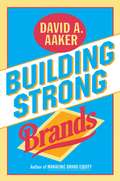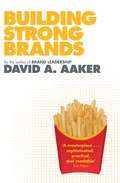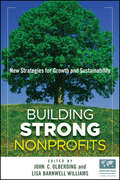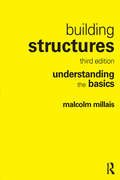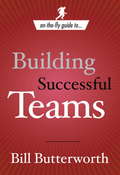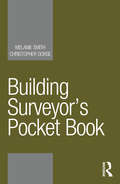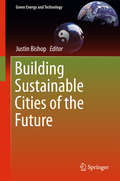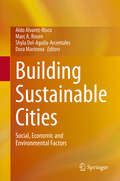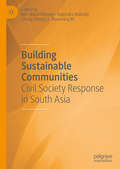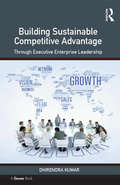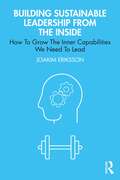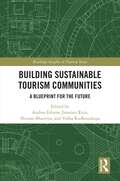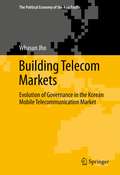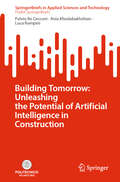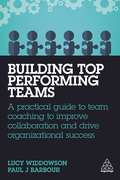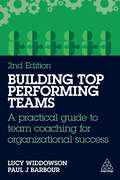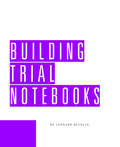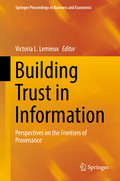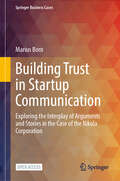- Table View
- List View
Building Strategy Maps
by Robert S. Kaplan David P. NortonBalanced Scorecard strategy maps help organizations see their strategies in a cohesive, integrated, and systematic way, overcoming the limitations of purely financial measurement systems by clearly portraying the value-creating processes and critical roles for intangible assets. This chapter introduces the task of building a strategy map, which describes the process of transforming intangible assets into tangible customer and financial outcomes, and provides executives with a framework for describing and managing strategy in a knowledge economy.
Building Strategy Maps in Private Sector Companies
by Robert S. Kaplan David P. NortonExemplar organizations develop and use the Balanced Scorecard to translate their strategies into linked cause-and-effect relationships that can be easily understood and communicated to the entire organization. Using a number of examples of product leadership companies, this chapter illustrates how Balanced Scorecard strategy maps are constructed from the underlying strategy of an organization, a process that makes strategy transparent.
Building Strategy and Performance
by Kim WarrenThe fundamental challenge facing business leaders is to drive performance into the future--the dynamics of strategy. To tackle this effectively, they need a clear understanding of what causes performance to improve or deteriorate and what power they have to change this trajectory for the better. Without this understanding, they risk making poor choices about their future--failing to exploit promising opportunities, pursuing unachievable aims, or falling victim to competitive and other threats. Building Strategy and Performance Through Time sets the agenda for building business strategy in powerful, actionable, and accessible terms. It gives executives clear frameworks for answering three fundamental questions: * Why is our business performance following its current path? * Where is it going if we carry on as we are? * How can we design a robust strategy to transform this future? The existing strategy tools most widely used help guide management's choices about where to compete--which customers to serve, with what products and services, and how to deliver those products and services to those customers effectively and profitably. While this choice is important, it is not often changed in any fundamental way; having found a reasonably strong and profitable position on these issues, few firms will, or should, set off in a new direction. But there is still much to be done to deliver that strategy, powerfully and sustainably over time. Many decisions need to be made, continually and holistically, across all functions of the business and adapted as conditions change from month to month and year to year. Pricing, product development, marketing, hiring, service levels, and other decisions cannot be made in isolation but must take into account other choices being made, elsewhere and at different times. Building Strategy and Performance Through Time explains a reliable, practical method, known as strategy dynamics, that creates a living picture of how an enterprise actually works and delivers performance. This picture shows exactly where the levers are that management controls and how to choose what to do, when, and how much, to accomplish your specific goals. It shows, too, how the same approach can be used to defeat competitors, cope with other outside forces, and keep delivering performance.
Building Strengths and Skills: A Collaborative Approach to Working with Clients
by Jacqueline CorcoranThis is a much-needed practice book that demonstrates how helping professionals can emphasize their clients' resilience, strength, and capacities, rather than focusing on pathology or deficits. It offers an integrative practice model for both assessment and intervention that interweaves strengths-based (specifically solution-focused therapy and motivational interviewing) and skills-building (cognitive-behavioral) approaches. In the strengths-and-skills-based model, helping professionals assume that clients possess the necessary capacities to solve their own problems, transforming the therapeutic relationship into a collaboration focused on bolstering motivation and resources for change. When these resources are exhausted or when deficits become a substantial barrier, then practitioner and client work to develop an individualized skills-building plan. A wide range of examples, written by Jacqueline Corcoran with experts from different fields of practice, clearly demonstrate how the model can be applied to individuals and families struggling with behavior problems, depression, substance abuse, anxiety, violence, and abuse, so that both strengths and skills maximize the client's success. This innovative, dynamic resource is a must have for practitioners across the helping, social service, and mental health professions.
Building Strong Banks
by Charles EnochThis publication contains guidance on setting up strong regulatory and supervisory systems to help prevent financial problems in the banking sector, as well as to deal with problems should a crisis erupt. It presents a collection of essays drawn from practical experience which discuss a wide range of issues including developing adequate standards for loan classification, provisioning liquid money markets, and the resolution and recapitalisation of failed banks.
Building Strong Brands
by David A. AakerAs industries turn increasingly hostile, it is clear that strong brand-building skills are needed to survive and prosper. In David Aaker's pathbreaking book, Managing Brand Equity, managers discovered the value of a brand as a strategic asset and a company's primary source of competitive advantage. Now, in this compelling new work, Aaker uses real brand-building cases from Saturn, General Electric, Kodak, Healthy Choice, McDonald's, and others to demonstrate how strong brands have been created and managed.A common pitfall of brand strategists is to focus on brand attributes. Aaker shows how to break out of the box by considering emotional and self-expressive benefits and by introducing the brand-as-person, brand-as-organization, and brand-as-symbol perspectives. The twin concepts of brand identity (the brand image that brand strategists aspire to create or maintain) and brand position (that part of the brand identity that is to be actively communicated) play a key role in managing the "out-of-the-box" brand.A second pitfall is to ignore the fact that individual brands are part of a larger system consisting of many intertwined and overlapping brands and subbrands. Aaker shows how to manage the "brand system" to achieve clarity and synergy, to adapt to a changing environment, and to leverage brand assets into new markets and products.Aaker also addresses practical management issues, introducing a set of brand equity measures, termed the brand equity ten, to help those who measure and track brand equity across products and markets. He presents and analyzes brand-nurturing organizational forms that are responsive to the challenges of coordinated brands across markets, products, roles, and contexts. Potentially destructive organizational pressures to change a brand's identity and position are also discussed.As executives in a wide range of industries seek to prevent their products and services from becoming commodities, they are recommitting themselves to brands as a foundation of business strategy. This new work will be essential reading for the battle-ready.
Building Strong Brands: Advertising's Role In Building Strong Brands (Advertising And Consumer Psychology Ser.)
by David A. AakerAs industries turn increasingly hostile, it is clear that strong brand-building skills are needed to survive and prosper. In David Aaker's pathbreaking book, MANAGING BRAND EQUITY, managers discovered the value of a brand as a strategic asset and a company's primary source of competitive advantage. Now, in this compelling new work, Aaker uses real brand-building cases from Saturn, General Electric, Kodak, Healthy Choice, McDonald's, and others to demonstrate how strong brands have been created and managed. A common pitfall of brand strategists is to focus on brand attributes. Aaker shows how to break out of the box by considering emotional and self-expressive benefits and by introducing the brand-as-person, brand-as-organisation, and brand-as-symbol perspectives. A second pitfall is to ignore the fact that individual brands are part of a larger system consisting of many intertwined and overlapping brands and subbrands. Aaker shows how to manage the "brand system" to achieve clarity and synergy, to adapt to a changing environment, and to leverage brand assets into new markets and products. As executives in a wide range of industries seek to prevent their products and services from becoming commodities, they are recommitting themselves to brands as a foundation of business strategy. This new work will be essential reading for the battle-ready.
Building Strong Nonprofits
by Williams John Olberding Lisa BarnwellA proven, strategic plan to help your nonprofit emerge from the 2008-2009 economic storm Utilizing the extensive expertise of leading fundraising consulting firm Skystone Ryan's executive leadership team and managing consultants to explore and illuminate the most timely issues facing the philanthropic community, Building Strong Nonprofits: New Strategies for Growth and Sustainability identifies new opportunities to define the future of philanthropy. Includes notable contributors from the Skystone Ryan leadership team Analyzes the most potent trends and developments and interpret their implications for the future of philanthropy Offers eight to twelve essays, each by a different Skystone Ryan consultant with particular experience, insight, and expertise in the area Building Strong Nonprofits: New Strategies for Growth and Sustainability is you, whether you are a nonprofit leader, executive director, board member, or development director, and are becoming aware that new organizational strategies are called for if the same old donors are not supportive in the same old ways.
Building Strong Partnerships at the Inter-American Development Bank
by Amy C. Edmondson Erin Henry Andreas Georgoulias Natalie BartlettBuilding Strong Partnerships at the Inter-American Development Bank details the development of the bank's new Office of Outreach Partnerships to sustain a culture of innovation through maintaining and generating partnerships in order to fulfill the bank's greater mission of providing multilateral development financing as well as non-financial technical support and expertise for the Latin American and Caribbean region. At the time the case takes place, the Latin American and Caribbean region had seen changes such as expansion of the middle class, emergence of a new business class, and integration with foreign trade. Additionally, the region had faced challenges such as poverty, education, productivity, and infrastructure in both small and medium enterprises. Finally, new actors had entered the region such as governments, corporations, foundations, academic institutions, and NGO's to take a supporting role. In response, the Inter-American Development Bank (IDB) had created the Office of Outreach and Partnerships (ORP) as a dedicated team to lead strategic collaboration and interactions with a long-term vision for partnerships and innovation. The case portrays key questions concerning how the partnership process was formalized through the development of ORP, and what innovations these new partnerships would bring to the bank. Three example partnerships are detailed including The Coca-Cola Company, The Salud Mesoamerica 2015 Initiative, and PepsiCo. The case concludes by positing questions the ORP would face moving forward such as incentives, metrics, restructuring to serve the private sector, and mechanisms for working with a new set of partners.
Building Structures: understanding the basics
by Malcolm MillaisThis is a one-stop book for knowing everything important about building structures. Self-contained and with no prerequisites needed, it is suitable for both general readers and building professionals. follow the history of structural understanding; grasp the concepts of structural behaviour via step-by-step explanations; apply these concepts to a simple building; see how these concepts apply to real buildings, from Durham Cathedral to the Bank of China; use these concepts to define the design process; see how these concepts inform design choices; understand how engineering and architecture have diverged, and what effect this had; learn to do simple but relevant numerical calculations for actual structures; understand when dynamics are important; follow the development of progressive collapse prevention; enter the world of modern structural theory; see how computers can be used for structural analysis; learn how to organise and design a successful project. With more than 500 pages and over 1100 user-friendly diagrams, this book is a must for anyone who would like to understand the fascinating world of structures.
Building Successful Teams
by Bill ButterworthThis little book could make a big change in the way you view your team. There’s little more energizing and fulfilling in life than the satisfaction of working well with others to accomplish a common goal. And this powerful little book can help you experience more team satisfaction than ever before Making use of his exceptional, humor-laced storytelling style, Bill Butterworth makes the basics of teamwork easy to grasp and easy to put to work. He sketches a memorable overview of teamwork that includes: ·the three great needs of team members ·the four great barriers to teamwork, and ·the five great traits of effective teams. It all adds up to a succinct understanding of how to work well as a team that will satisfy leaders, managers, coaches–anyone who wants to know how to make a group perform at high levels while enjoying the camaraderie and satisfaction of being “us. ” Also look for the On-the-Fly-Guide toBalancing Work and Life! From the Trade Paperback edition.
Building Surveyor’s Pocket Book (Routledge Pocket Books)
by Melanie Smith Christopher GorseBuilding Surveyor’s Pocket Book is an accessible encyclopaedia of matters vital to building surveyors. Well-illustrated with diagrams, pictures, tables, and graphs, it covers all essential elements of building pathology, building performance, and building construction terminology in a simple, accessible way for the practitioner and student. This Pocket Book provides a practical and portable reference text, working as a first-stop publication for those wishing to refresh their knowledge or in need of guidance on surveying practice. Working through fundamental principles in key practice areas, the book is not overly bound by the regulation and legislation of one region, and the principles can be applied internationally. This book is ideal reading for individual surveyors, practitioners, and students in building surveying, facilities management, refurbishment, maintenance, renovation, and services management. It is also of use for those interested in building forensics, building performance, pathology, and anyone studying for their RICS APC. Many other professions in architecture, contracting, engineering, and safety will also find the book of use when undertaking similar practice.
Building Sustainable Cities of the Future (Green Energy and Technology)
by Justin BishopThis book draws upon the expertise of academic researchers, urban planners and architects to explore the challenge of building the sustainable cities of the future. It addresses this challenge by considering current cities and those of the near future, and creates a picture of the sustainable city from the bottom up. Individual chapters cover topics such as transport, energy supply, sustainable urbanism and promoting social equality in large infrastructure projects. Real-world examples are presented to illustrate how systems thinking is used to integrate different components of a city so as to ensure that the whole is more sustainable than its parts. Written in an accessible style, this book is intended for general readers as much as it is for students and researchers interested in sustainable cities and related topics. It is also ideal for urban planners seeking best-practice guidelines for sustainable urban development.
Building Sustainable Cities: Social, Economic and Environmental Factors
by Marc A. Rosen Aldo Alvarez-Risco Dora Marinova Shyla Del-Aguila-ArcentalesThis book describes a broad view of sustainability as a crucial factor for the success of its implementation. Not only the environmental aspects of the sustainable cities´ development are reviewed but the economic and social aspects of it, as highlighted in the UN Sustainable Development Goal 11 (make cities and human settlements inclusive, safe, resilient and sustainable).Nowadays, researchers, students, and stakeholders are highly involved in sustainability issues. Because of this, they need a guiding document to help them develop and implement sustainability programs at the level of companies and institutions.In this book, the authors discuss and explain basic concepts of sustainability-related to social, economic and environmental aspects, as well as strategies for its implementation.
Building Sustainable Communities: Civil Society Response in South Asia
by Rajendra Baikady Md. Nurul Momen Cheng Sheng Li M. BasavarajThe book aims to explore South Asian third sector – the nonprofit organizations as provider of social services. The book defines social welfare and describe its relationship to social service programmes and individual well-being; understands the social policy development from the problem identification to policy implementation; describes the range of organization of social service agencies that are responsible for providing social welfare programmes; explores the various roles that professional and non- professional helpers provide in the delivery of social welfare and their influence in promoting change in policy development; and understands the umbrella concept of Child welfare, welfare of people with disability and elderly welfare in welfare policy.
Building Sustainable Competitive Advantage: Through Executive Enterprise Leadership
by Dhirendra KumarIn Building Sustainable Competitive Advantage Dhirendra Kumar shows how the Enterprise Excellence (EE) philosophy is a holistic approach for leading an enterprise to total excellence. It does this by focussing on achieving sustainable significant growth in revenue and profitability, reducing the business cycle time, strategically managing the enterprise risk and focusing on the needs of the customer. There may be various organizations within an enterprise but they must all focus on meeting or exceeding customer needs. Therefore, EE is an integrated approach affecting every employee, every functional area and strategy within the organization. Enterprise risk must be identified, assessed and prioritized; developing a growth strategy proposal which leadership has to execute in order to achieve goals. As business leaders spearhead the efforts, they must minimize, monitor and control the probability and/or impact of unfortunate events and maximize the realization of opportunities. The achievements in Enterprise Excellence can range from greater cost efficiencies, improved market perceptions, fundamental changes to markets, to new product and service offerings. There may also be significant upgrades in skills, technology, and business strategies. The scope of Enterprise Excellence can also range from operations activities, to business functions, to overall organization and to the enterprise as a whole. Building Sustainable Competitive Advantage is a comprehensive reference book for practising professionals, teaching faculty, and students alike.
Building Sustainable Leadership from the Inside: How To Grow The Inner Capabilities We Need To Lead
by Joakim ErikssonDrawing on contemporary neuroscience, this book shows leaders how they can literally train their mind to become more resilient and have a more sustainable impact.This is a research‑backed and practical guide for how to grow inner capabilities enabling sustainable leadership in this time. It is built around five areas that many leaders will recognize as being challenging on a personal level, such as how to stay calm under pressure, navigate in uncertainty or collaborate skilfully with people with diverse points of views. While many leadership books describe the importance of such traits, few show how to actually cultivate them. Grounded in multiple fields of research, this book offers a practical training manual for the mind. With more than 40 reflections and exercises, it offers a guided tour to an ‘inner gym’, showing readers how to cultivate these capabilities.Leaders who have realized that it takes more than IQ and theoretical knowledge to create sustainable impact and are looking for ways to deepen their leadership capacity and authenticity will find them in this practical training manual for the mind.
Building Sustainable Tourism Communities: A Blueprint for the Future (Routledge Insights in Tourism Series)
by Volha Rudkouskaya Shivam Bhartiya Jimenez Ruiz, Andrea EdurneThis book offers a comprehensive framework for fostering sustainable tourism communities, providing actionable strategies to balance economic growth, environmental preservation, and social equity. It serves as a vital resource for professionals and scholars striving to create resilient tourism models.Featuring real-world case studies, actionable frameworks, and interdisciplinary perspectives, the book combines theory with practice to equip readers to address challenges such as climate change, cultural preservation, and stakeholder collaboration effectively. Readers will gain practical insights and tools to design and implement sustainable tourism initiatives as this book explores the crucial interactions between tourism, environmental protection, socio-cultural integrity, and economic growth, drawing on substantial research and case studies.This book is ideal for tourism professionals, policymakers, sustainability advocates, scholars, and students in tourism and environmental studies as well as community leaders seeking to build tourism strategies rooted in sustainability and resilience.
Building Telecom Markets: Evolution of Governance in the Korean Mobile Telecommunication Market (The Political Economy of the Asia Pacific)
by Whasun JhoThe mobile telecommunication industry has been one of the fastest growing industries in the global economy since the late 1990s. As the first country to offer commercial Code Division Multiple Access (CDMA) cellular service in the world, Korea was able to jump right into the digital mobile markets, enhancing its status as a leading manufacturer of mobile equipment. While the growth of the telecom industry occurred with the emergence of worldwide market-oriented regulatory reform and liberalization in telecommunications, the state-market relationship in Korea evolved from state monopoly toward "centralized governance" and later toward "flexible governance," which is substantially different from "liberal governance" of the US. This book examines the uniqueness of Korean regulatory reforms of the mobile telecommunication sector, and argues that the market-oriented regulatory reform and liberalization should be explained by focusing on the interactions among the state, the private sector, and international political economic environment. It will appeal to scholars and policy-makers alike concerned with market regulation, Asian development and political economy.
Building Tomorrow: Unleashing the Potential of Artificial Intelligence in Construction (SpringerBriefs in Applied Sciences and Technology)
by Fulvio Re Cecconi Ania Khodabakhshian Luca RampiniThis book explores the transformative impact of artificial intelligence (AI) on the construction industry, examining its readiness for widespread integration and its potential to reshape various facets of the construction lifecycle. It introduces the concept of a readiness metric tailored to the construction sector, providing a comprehensive framework for assessing and improving AI adoption. The narrative then shifts to the early stages of projects, highlighting the role of AI in promoting sustainability. From leveraging open data for data-driven decisions to using machine learning for strategic decisions in retrofitting and decarbonising the built environment, the book investigates how AI can be a catalyst for positive change in the construction process. It then explores the integration of AI into project and risk management, unlocking the potential of advanced analytics and predictive modelling to streamline processes and improve decision-making, and the application of AI in asset and facility management, highlighting how intelligent technologies can optimise the lifecycle of built assets. Examining the responsible use of AI tools, the book addresses ethical challenges and outlines guidelines for the conscientious and equitable integration of AI into the construction ecosystem. Overall, it serves as a comprehensive guide for industry professionals, researchers, and policymakers, providing insights into the current landscape, the potential of AI, and the ethical considerations necessary for responsible implementation.
Building Top-Performing Teams: A Practical Guide to Team Coaching to Improve Collaboration and Drive Organizational Success
by Lucy Widdowson Paul J BarbourThe best way for a business to succeed is through its people. While there are gains to be had from streamlining processes, reducing costs or making a strategic change, the biggest potential for success comes through how humans collaborate. Specifically, the greatest gains are achieved through high performing teams, and teams of teams. Containing more than 40 tools which can be used in a virtual or in-person coaching environment, Building Top-Performing Teams is a practical guide for leaders, HR professionals, coaches, team coaches and anyone with management responsibility. It covers how to motivate, develop, engage and reward a team of employees with different levels of experience and priorities to achieve outstanding business success.Building Top-Performing Teams includes essential guidance, tools and techniques that show how to promote team ways of working rather than individual-focused processes. It also includes guidance on managing internal team conflict and ensuring that teams are purpose-driven and working towards a shared business goal. Each chapter includes diagnostic questions and reflective practice exercises to allow readers to identify how to apply each element of team development to their workforce. Supported by the authors' experience in organizations such as the BBC, John Lewis, KPMG, Britvic, the NHS and BMW this is essential reading for anyone needing to unlock the value of teams to achieve greater business performance.
Building Top-Performing Teams: A practical guide to team coaching for organizational success
by Lucy Widdowson Paul J BarbourThe best way for a business to succeed is through its people. While there are gains to be had from streamlining processes, reducing costs or making a strategic change, the biggest potential for success comes from how humans collaborate. Containing more than 60 tools which can be used in a virtual or in-person coaching environment, Building Top-Performing Teams is a practical guide for leaders, HR professionals, coaches, team coaches and anyone with management responsibility. It covers how to motivate, develop, engage and reward a diverse team of employees with different levels of experience and priorities to achieve outstanding business success. This updated edition includes new research and insights into team coaching and the dynamics of collaborative environments, as well as understanding diversity, neurodiversity and inclusion in the workplace. Incorporating essential guidance, tools and techniques that show how to promote team ways of working rather than individual-focused processes, this book also shows how to manage internal team conflict and ensure that teams are purpose-driven and working towards a shared business goal. Each chapter includes reflective questions and exercises to allow readers to identify how to apply each element of team development to their workforce.
Building Trial Notebooks
by Leonard BucklinLeonard Bucklin's proven and highly-visible approach to litigation preparation will ensure that your cases and you are always ready for the next skirmish... even when unanticipated issues and arguments arise. Mr. Bucklin, who has been identified by the International Academy of Trial Lawyers as one of the top 500 trial lawyers in the U.S., created and polished his litigation preparation system over decades of high-stakes trial work. Now the Bucklin system is available to help you: Plan all aspects of your case so you hit every important point Organize your case from opening to closing Materially reduce your trial preparation time Assemble any case at low cost Keep each document at your fingertips Place litigation matters on staff auto-pilot Keep opposing counsel on the defensive Earn the respect of the court and opposing counsel with your organization and readiness The Bucklin litigation preparation system will also make you and your case settlement-ready. And your readiness, confidence, and organization will be visible. At depositions and conferences, defense counsel will see that you are prepared and focused, your trial notebook is steadily growing in size and value, and your strategies and forms are painfully effective.
Building Trust in Information: Perspectives on the Frontiers of Provenance (Springer Proceedings in Business and Economics)
by Victoria L. LemieuxThis book reports on the results of an interdisciplinary and multidisciplinary workshop on provenance that brought together researchers and practitioners from different areas such as archival science, law, information science, computing, forensics and visual analytics that work at the frontiers of new knowledge on provenance. Each of these fields understands the meaning and purpose of representing provenance in subtly different ways. The aim of this book is to create cross-disciplinary bridges of understanding with a view to arriving at a deeper and clearer perspective on the different facets of provenance and how traditional definitions and applications may be enriched and expanded via an interdisciplinary and multidisciplinary synthesis. This volume brings together all of these developments, setting out an encompassing vision of provenance to establish a robust framework for expanded provenance theory, standards and technologies that can be used to build trust in financial and other types of information.
Building Trust in Startup Communication: Exploring the Interplay of Arguments and Stories in the Case of the Nikola Corporation (Springer Business Cases)
by Marius BornThis open access book explores the intriguing narrative of Nikola Corporation's startup journey in this insightful case study, examining its rapid ascent and subsequent decline from both a narrative and argumentative perspective. Founded by Trevor Milton, Nikola initially garnered investor interest with promises of a cleaner, sustainable alternative to diesel trucks. However, the company's surge in valuation was short-lived, as accusations from a short seller triggered a trust crisis, exposing alleged deception and raising doubts about the company's technology claims. This case study particularly focuses on the nuances of startup communication, emphasizing the critical importance of effective and trustworthy strategic communication for emerging tech ventures. It provides an in-depth look at the methods and tools necessary for startups to navigate initial skepticism and data limitations without exposing themselves to potential crises. Key insights include crafting compelling startup stories while maintaining trustworthiness, meeting investor information needs in an argumentatively convincing structure, recognizing the risks of blind faith in charismatic founders, and implementing internal checks and balances to safeguard against deception. Nikola's story serves as a cautionary tale, offering valuable lessons for entrepreneurs, investors, and scholars alike. This comprehensive examination sheds light on the challenges faced by startups dependent on emerging technologies and ambitious promises, making it an indispensable addition to the reading list of entrepreneurs.

